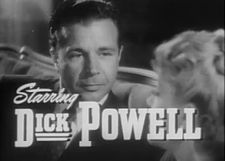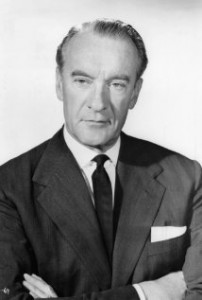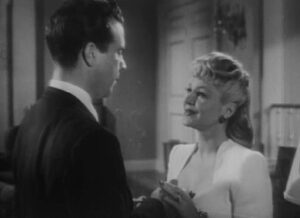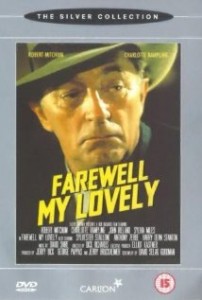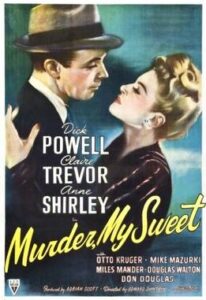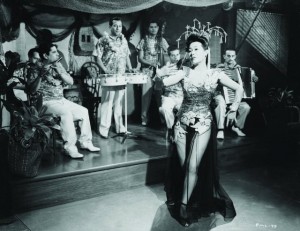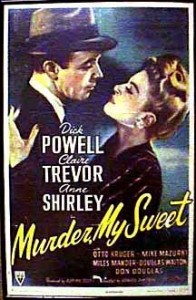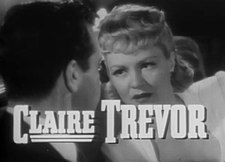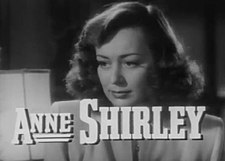Farewell, My Lovely [Murder, My Sweet] ***** (1944, Dick Powell, Claire Trevor, Anne Shirley) – Classic Movie Review 739
The 1944 American film noir Farewell, My Lovely [Murder, My Sweet] stars Dick Powell in the first film to feature Raymond Chandler’s hard-boiled private detective Philip Marlowe.
‘A Sensational Triumph for the NEW Dick Powell.’
Director Edward Dmytryk’s 1944 American film noir Farewell, My Lovely [Murder, My Sweet] stars Dick Powell, Claire Trevor and Anne Shirley in her final film before she retired, and is based on Raymond Chandler’s 1940 novel Farewell, My Lovely. It is the first film to feature Chandler’s hard-boiled private detective Philip Marlowe, is one of the first and finest film noir movies, and is a cornerstone of the much-loved genre.
Dick Powell bid farewell to the crooning day job when he took over the persona of Raymond Chandler’s classic hard-boiled private eye Philip Marlowe, up to his neck as usual in bodies and blackmail as he searches for an ex-convict’s long-missing girlfriend.
Marlowe is hired by Moose Malloy (Mike Mazurki), a petty crook just out of prison after a seven-year stretch, to look for his former girlfriend, Velma (Claire Trevor), who has not been seen for the last six years. Murder and mayhem inevitably follow.
In a portrayal perhaps surprisingly approved by Chandler himself, Powell is wonderfully droll and world-weary. He has a flinty, ironic look about his eyes, and a stylishly cynical way with the tough-toned dialogue. And there are other glorious performances from Claire Trevor as the seductive femme fatale Mrs Helen Grayle aka Velma Valento, Anne Shirley as her step-daughter Ann Grayle, the hulking 6′ 5″ Mike Mazurki as the huge heavy, bulky bruiser Moose Malloy, and Otto Kruger as the blackmailer Jules Amthor.
Although Chandler was originally strongly opposed to Powell’s casting, he eventually said he was very fond of Powell’s interpretation. But later, after seeing Marlowe played by Humphrey Bogart in The Big Sleep (1946), he changed his mind to prefer Bogart’s portrayal.
Screenwriter John Paxton captures the nasty Chandler low-life atmosphere perfectly, and director Edward Dmytryk turns it into a classic film noir, with fine work on score by composer Roy Webb and black and white cinematography by Harry J Wild. The main triumphs, though, belong to Chandler (expectedly) and Powell, who basically took everyone by surprise.
The film won the 1946 Edgar Award [Edgar Allan Poe award] for Best Motion Picture from the Mystery Writers of America, along with three other Edgar Awards: John Paxton (screenplay), Raymond Chandler (author) and Dick Powell (actor).
It was released in America as Murder, My Sweet because the studio thought that with the original title audiences might expect Powell to sing. When the RKO studio changed the title to Murder, My Sweet, box office receipts picked up considerably.The exact story is this. The film was first screened on 18 December 1944 in Minneapolis, Minnesota, as Farewell, My Lovely, and previewed in New England cinemas with that title. However, a survey by Audience Research Inc then found patrons thought the title suggested a Dick Powell musical, so RKO changed it to Murder, My Sweet, delaying its release. It then opened in New York City on 8 March 1945 as Murder, My Sweet. But it was released as Farewell, My Lovely in the UK.
RKO was in financial difficulties when it signed Powell to make a series of musicals, but he agreed only if he could play a dramatic role first, so he was cast as Marlowe, horrifying director Dmytryk and producer Adrian Scott at first. Dmytryk recalled: ‘The idea of the man who had sung ‘Tiptoe Through the Tulips’ playing a tough private eye was beyond our imaginations’. So, Powell had to make a screen test, after which RKO’s studio boss Charles Koerner offered him a multi-picture contract.
Pro-wrestler-turned-actor Mike Mazurki also had to make a screen test and convinced Dmytryk in a studio commissary discussion to give him a chance, with Powell’s help.
It all went well, very well. The film made a profit of $597,000 on a $400,000 budget. The success of the film and Powell’s performance led Koerner to drop the idea of casting Powell in musicals and cast him as other tough guy characters and in action films. It also revitalised the career of Claire Trevor, re-defined as a femme fatale.
Raymond Chandler’s 1940 novel Farewell, My Lovely was originally made by RKO with George Sanders as The Falcon Takes Over in 1942, using the essentials of the plot and characters but without featuring Philip Marlowe, and it was eventually remade as Farewell, My Lovely with Robert Mitchum as Marlowe in 1975.
http://derekwinnert.com/farewell-my-lovely-mitchum-1975-classic-film-review-740/
RKO Radio Pictures bought the rights to Chandler’s Farewell, My Lovely for $2,000, a small amount considering the film’s $400,000 budget. RKO’s studio boss Charles Koerner wanted to make a true adaptation of the novel and convinced the studio management to make a new version so soon after RKO’s previous one The Falcon Takes Over (1942} by saying the book would take little adapting for a screenplay. And thus it largely was, though with some exceptions.
Screenwriter John Paxton was a reporter and publicist whose only previous feature was My Pal Wolf (1944), a film about a girl and her dog. Here he takes Chandler’s advice: ‘When your plot hits a snag, have somebody come through the door with a gun’, and Paxton’s screenplay follows Chandler’s novel closely. However, aspects of Chandler’s plot are downplayed because of the Production Code, such as Lindsay Marriott’s homosexuality, or the idea that Jules Amthor and Dr Sonderborg were providing drugs for LA elites.
A plotline involving a fleet of gambling boats off the LA coast was dropped because real-life mobster Anthony Cornero ran this kind of fleet and was host to many of Hollywood’s elites. Florian’s African American club in L.A.’s black district was changed so the film could release in Southern states.
So, no gays, drugs, gambling, mobsters, or African Americans then.
In another change, Ann Grayle was originally the daughter of an honest cop, but now she is the femme fatale Helen’s step-daughter. Shirley and Trevor tried to persuade their bosses to swap roles and play against type, but in vain.
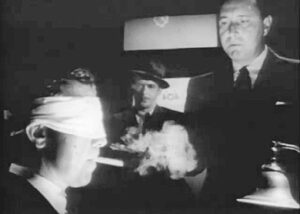
Philip Marlowe with his eyes bandaged being interrogated by Police Lieutenant Randall (Don Douglas) about two murders.
However, it was producer Adrian Scott’s idea to shoot the film as an extended flashback to reflect the book’s first-person narrative style, and the film starts with Philip Marlowe with his eyes bandaged being interrogated by Police Lieutenant Randall (Don Douglas) about two murders.
My Pal Wolf had seen the debut of producer Adrian Scott, a Communist who became a member of the Hollywood Ten, a group of blacklisted film industry professionals who refused to testify to the House Un-American Activities Committee (HUAC) in their investigations during the McCarthy-era Red Scare. In 1947, Edward Dmytryk was also named as one of the Hollywood Ten, who all served time in prison for contempt of Congress. However, in 1951, Dmytryk testified to the HUAC and named individuals, whose lives and careers were destroyed, to rehabilitate his own career.
It was shot from 8 May 1944 to 1 July 1944. Night location filming took place in the Hollywood Hills. During breaks between scenes, Dick Powell would entertain the other actors with imitations of himself as a singer earlier in his film career. How ironic is that! At any rate, for once the advertising was true, it was ‘A Sensational Triumph for the NEW Dick Powell.’
The cast
The cast are Dick Powell as Philip Marlowe, Claire Trevor as Helen Grayle/ Velma Valento, Anne Shirley as Ann Grayle, Otto Kruger as Jules Amthor, Mike Mazurki as Moose Malloy, Miles Mander as Mr Grayle, Douglas Walton as Lindsay Marriott, Don Douglas as Police Lieutenant Randall, Ralf Harolde as Dr Sonderborg, Esther Howard as Mrs Jessie Florian, John Indrisano as chauffeur and Amthor’s henchman, and Dewey Robinson as New Boss at Florian’s club.
© Derek Winnert 2014 Classic Movie Review 739
Check out more reviews on http://derekwinnert.com/

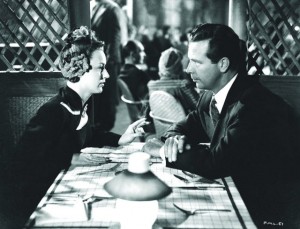
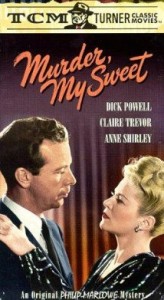
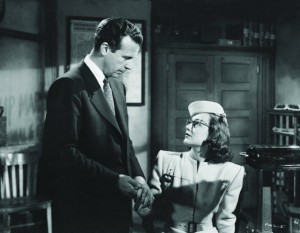
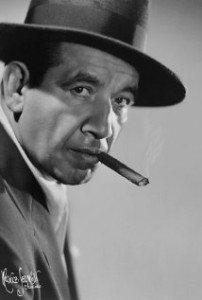
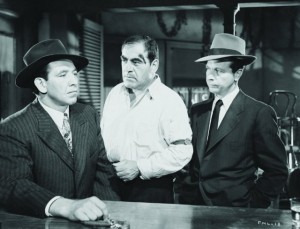
![Farewell, My Lovely [Murder, My Sweet] (1944, Dick Powell, Claire Trevor).](http://www.derekwinnert.com/wp-content/uploads/2014/01/4139-300x220.jpg)
